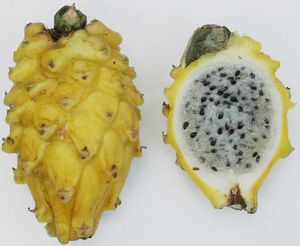Difference between revisions of "Hylocereus megalanthus"
From PlantUse English
Maëva Rouxel (Talk | contribs) m (→Popular names: clean up) |
Maëva Rouxel (Talk | contribs) m (→Description: clean up) |
||
| Line 17: | Line 17: | ||
|} | |} | ||
| − | == | + | == Description == |
Fruit yellow with conical tubercles ended with spines (which are removed before marketing). Pulp white or purple. | Fruit yellow with conical tubercles ended with spines (which are removed before marketing). Pulp white or purple. | ||
Revision as of 16:16, 9 August 2016
Hylocereus megalanthus
(K. Schum. ex Vaupel) Ralf Bauer
| Order | Caryophyllales |
|---|---|
| Family | Cactaceae |
| Genus | Hylocereus |
2n =
Origin : Colombia, Peru
wild and cultivated
| English | {{{english}}} |
|---|---|
| French | {{{french}}} |
Contents
Popular names
Description
Fruit yellow with conical tubercles ended with spines (which are removed before marketing). Pulp white or purple.
Classification
Hylocereus megalanthus (K. Schum. ex Vaupel) Ralf Bauer (2003)
basionym
- Cereus megalanthus K. Schum. ex Vaupel (1913)
synonyms
- Mediocactus megalanthus (K. Schum. ex Ule) Britton & Rose (1920)
- Selenicereus megalanthus (K. Schum. ex Vaupel) Moran (1953)
Cultivars
The pulp of the edible fruits can be white or purple (Bauer, 2003).
History
The yellow pitahaya is now commercially grown in Colombie, and appears in international markets of exotics. It is much less common than the red pitahaya.
Uses
References
- Bauer, R., 2003. A synopsis of the tribe Hylocereeae F. Buxb. Cactaceae Systematics Initiatives, 17: 3-63.
- Le Bellec, Fabrice, 2011. Les pitahayas (Hylocereus spp.). jaunes, rouges... quelques clés pour mieux les connaître et les reconnaître. Fruitrop, 195 : 29-33.
- Le Bellec, Fabrice & Vaillant, F., 2011. Pitaya, Pitahaya (Hylocereus spp.). In Yahia Elhadi M. (ed.), Postharvest Biology and Technology of Tropical and Sub-Tropical Fruits, vol. 4: Mangosteen to white sapote. Cambridge, UK, Woodhead Publishing Limited, 247-271.
- Mizrahi, Yosef, Nerd, Avinoam et Nobel, Park S., 1997. Cacti as crops. Horticultural Reviews, 18 : 291-319, 4 pl. coul.
- Nerd, Avinoam & Mizrahi, Yosef, 1997. Reproductive biology of cactus fruit crops. Horticultural Reviews, 18 : 321-346.
- Tel-Zur, N., Abbo, S., Bar-Zvi, D. & Mizrahi, Y., 2004. Genetic relationships among Hylocereus and Selenicereus vine cacti (Cactaceae): evidence from hybridization and cytological studies. Ann. Bot. (Lond.), 94(4): 527-34.
- Weiss, J., Scheinvar, L. & Mizrahi, Y., 1995. Selenicereus megalanthus (the yellow pitaya): a climbing cactus from Colombia. Cactus Succulent J., 67 : 280-283.

